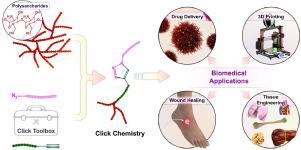Progress in Polymer Science ( IF 26.0 ) Pub Date : 2022-08-09 , DOI: 10.1016/j.progpolymsci.2022.101590 Mohsen Khodadadi Yazdi 1 , S Mohammad Sajadi 2, 3 , Farzad Seidi 1 , Navid Rabiee 4 , Yousef Fatahi 5, 6 , Mohammad Rabiee 7 , Midhun Dominic C D 8 , Payam Zarrintaj 9 , Krzysztof Formela 10 , Mohammad Reza Saeb 10 , Sidi A Bencherif 11, 12, 13, 14

|
Recent advances in materials science and engineering highlight the importance of designing sophisticated biomaterials with well-defined architectures and tunable properties for emerging biomedical applications. Click chemistry, a powerful method allowing specific and controllable bioorthogonal reactions, has revolutionized our ability to make complex molecular structures with a high level of specificity, selectivity, and yield under mild conditions. These features combined with minimal byproduct formation have enabled the design of a wide range of macromolecular architectures from quick and versatile click reactions. Furthermore, copper-free click chemistry has resulted in a change of paradigm, allowing researchers to perform highly selective chemical reactions in biological environments to further understand the structure and function of cells. In living systems, introducing clickable groups into biomolecules such as polysaccharides (PSA) has been explored as a general approach to conduct medicinal chemistry and potentially help solve healthcare needs. De novo biosynthetic pathways for chemical synthesis have also been exploited and optimized to perform PSA-based bioconjugation inside living cells without interfering with their native processes or functions. This strategy obviates the need for laborious and costly chemical reactions which normally require extensive and time-consuming purification steps. Using these approaches, various PSA-based macromolecules have been manufactured as building blocks for the design of novel biomaterials. Clickable PSA provide a powerful and versatile toolbox for biomaterials scientists and will increasingly play a crucial role in the biomedical field. Specifically, bioclick reactions with PSA have been leveraged for the design of advanced drug delivery systems and minimally invasive injectable hydrogels. In this review article, we have outlined the key aspects and breadth of PSA-derived bioclick reactions as a powerful and versatile toolbox to design advanced polymeric biomaterials for biomedical applications such as molecular imaging, drug delivery, and tissue engineering. Additionally, we have also discussed the past achievements, present developments, and recent trends of clickable PSA-based biomaterials such as three dimensional printing, as well as their challenges, clinical translatability, and future perspectives.
中文翻译:

用于生物医学应用的可点击多糖:全面综述
材料科学和工程的最新进展凸显了为新兴生物医学应用设计具有明确结构和可调特性的复杂生物材料的重要性。点击化学是一种允许特定且可控的生物正交反应的强大方法,彻底改变了我们在温和条件下制造具有高水平特异性、选择性和产量的复杂分子结构的能力。这些特征与最少的副产物形成相结合,使得能够通过快速且多功能的点击反应设计各种大分子结构。此外,无铜点击化学导致了范式的改变,使研究人员能够在生物环境中进行高度选择性的化学反应,以进一步了解细胞的结构和功能。在生命系统中,将可点击基团引入多糖(PSA)等生物分子中已被探索作为进行药物化学并可能有助于解决医疗保健需求的通用方法。化学合成的从头生物合成途径也已被开发和优化,以在活细胞内进行基于 PSA 的生物共轭,而不干扰其天然过程或功能。这种策略避免了费力且昂贵的化学反应,而化学反应通常需要大量且耗时的纯化步骤。利用这些方法,各种基于 PSA 的大分子已被制造出来,作为新型生物材料设计的构建模块。Clickable PSA 为生物材料科学家提供了强大且多功能的工具箱,并将在生物医学领域发挥越来越重要的作用。具体来说,PSA 的生物点击反应已被用于先进药物输送系统和微创注射水凝胶的设计。在这篇综述文章中,我们概述了 PSA 衍生的生物点击反应的关键方面和广度,作为一个强大且多功能的工具箱,用于设计用于分子成像、药物输送和组织工程等生物医学应用的先进聚合物生物材料。此外,我们还讨论了可点击 PSA 生物材料(例如三维打印)的过去成就、当前发展和最新趋势,以及它们的挑战、临床可转化性和未来前景。











































 京公网安备 11010802027423号
京公网安备 11010802027423号